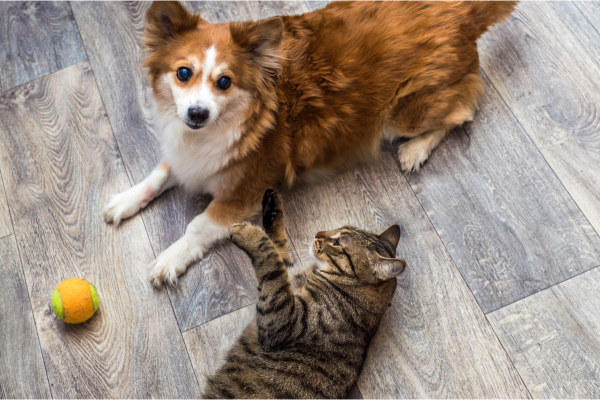So you may have heard the term pet enrichment, but what does it actually mean?
Pet enrichment involves finding ways to offer a complex and interesting environment to your pet. It’s also a way of offering your pet opportunities for mental stimulation and ways to engage in normal behaviours.
When our pets come to live with us, naturally we have a significant amount of control over their lives. Whilst this is essential to keep them safe, healthy and to ensure they fit into our lives, sometimes it means our pets don’t have the option to express normal behaviour, or to use their brain.
Normal Behaviours In Dogs
Normal behaviours in dogs can sometimes be considered ‘naughty’. These can include sniffing, digging, chewing and barking. They are, however a normal part of the canine behaviour repertoire. Without the ability to perform normal behaviours, or to engage in mental stimulation, a dog may be more likely to show problematic behaviours.
They may dig up your garden, chew your furniture or skirting boards, or sniff constantly on walks. Hence, if we can offer them appropriate ways to express these behaviours, for example chewing suitable dog chews, digging in a sandpit, or sniffing with scent games, then they’re more likely to be content and fulfilled. They’ll have less desire to engage in all those problematic behaviours at inconvenient times and in inappropriate ways!
Normal Behaviours In Cats
Cats also have a range of behaviours which are normal feline behaviours. These include scratching, chewing, hunting (stalking, chasing, pouncing and grabbing) and hiding. Cats with limited outdoor access may struggle for opportunities to engage in these behaviours, which may cause stress. Stress in cats can lead to behavioural problems such as tension between cats and spraying or soiling inside the home.
This means that the more opportunities we can give cats to practise these behaviours the more content they’re likely to be. You can offer them scratching posts, interactive play with toys to mimic hunting and cardboard boxes with hidden treats for them to find.
Pet Enrichment & Mental Stimulation
Providing opportunities for the expression of normal dog and cat behaviour is one major benefit of pet enrichment. However, enrichment can also give your pet the chance to engage their brain. This can help to wear your pet out and encourage a content pet without the need for excessive physical exercise.
Opportunities To Use Their Senses
Food enrichment activities are a common method of enrichment. However, you can get creative with enriching your pet’s environment in a way which engages their senses, including sight, sound, smell, touch and taste. Enrichment can basically include anything which adds interest to your pet’s life in a positive way. It can be both indoors and outdoors and incorporate physical exercise and mental processing.
Restricted Environments
It’s great to think about incorporating enrichment no matter what environment your pet’s in. But, it’s especially important if they’re in a restricted environment for example, a cat living indoors, or a dog on rest due to injury, or surgery, or who is at home for long periods. Restricted environments lack opportunities for engagement with the environment, so pets may struggle.
Individuality
It’s always best to tailor enrichment to your individual pet. Suitable activities will vary depending on your pet’s age, health status, breed and temperament. It’s useful to observe your pet and take note of what sort of behaviours and activities they enjoy. Then, follow their lead and tailor activities accordingly.
Avoid Frustration
When we introduce enrichment activities we want it to be a positive experience for pets. This means it’s important to keep activities simple initially and gradually increase difficulty. If an activity such as a puzzle feeder is too challenging, it may cause your pet frustration and this may mean they don’t show an interest in it again.
Keep It Simple
Pet enrichment activities don’t need to be complicated, or expensive. In fact, the best ideas are simple and free. You could fill a box with items from the outdoors (twigs, pinecones, leaves etc). for your indoor cat to explore, or hide your dog’s biscuits in a wrapped-up towel for them to figure out how to get the biscuits. Always ensure activities are safe, start simple and gradually increase difficulty, or incorporate more elements.
To sum up, it’s all about thinking outside of the box and being creative!
Find out more here:
Find examples for both dog and cat enrichment activities on my Instagram highlights.
Follow me on social media:

